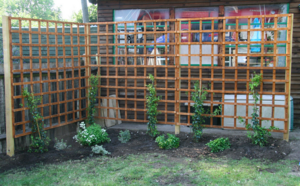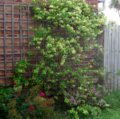
A trellis is a latticed and gridded wooden structure that is used for keeping plants growing upward. It can also be used to create private areas of a garden (such as privacy screens or walled off spaces) or to form specific breaks between different areas of a garden.
Consisting of horizontal crosspieces and vertical supports, it is often placed against a structure, such as a wall or a fence. However it can also be free-standing, if adequately supported. The trellis is usually shaped either as a rectangle or a square but can be formed into other shapes. Trellis can also be formed into artistic architectural designs such as pergolas or walkway covers.
Trellis is ideal for climbing plants and plants that like to attach by spiralling around something. This includes creepers, climbers, fruit trees, shrubs, young trees, vegetables and flowers. Fruit trees can be espaliered, a method to pin fruit trees to specific and confined directions for growing (to make fruit retrieval easier and to keep the size of the tree under control).
Materials for a trellis[edit | edit source]
Common materials for trellis include willow, bamboo, pine (often treated), thin wood, metal (wire), monofilament, waterproof synthetic materials and repurposed items. It can be purchased ready-made from hardware stores, garden centres and nurseries, or you can make your own using lightweight yet strong wood. A trellis must be sturdy enough to hold the plant as it grows.
Using trellis as a trompe l'oeil[edit | edit source]
Trellis can be used in the garden context to create a trompe l'oeil. This refers to an "illusion" in which a garden space can be made to appear larger than it actually is by the placement of trellis in a design pattern that suggests depth. This can be done by the shape of the trellis (such as an archway made from trellis attached to a plain single coloured wall, suggestive of a hole to step through into the beyond. Or, it can be done with the use of a mirror, such as placing a mirror in the centre and surrounding it with trellis as a border, including climbing plants. The mirror reflects back the garden, making it appear as if there is more garden space and the trellis border amplifies the sense of space. These trompe l'oeil uses of trellis are good for end walls or fences. In the case of using a mirror, be sure to hide the mirror edges well underneath the trellis edges, to give the impression of no edge and thus enhancing the illusion of depth and space.
Plants suitable for trellises[edit | edit source]
Many plants can benefit from being planted alongside a trellis. Here are some plants that are typically grown against a trellis:
- Honeysuckle
- Climbing, rambling roses
- Passion flower
- Morning glory (Ipomoea purpurea)
- Star jasmine (Jasminum spp.)
- Clematis
- Grapes
- Pole beans (Phaeolus vulgaris)
- Scarlet runner beans (Phaseolus coccineus)
- Peas (Pisum sativum)
- Cucumber (Cucumis sativus)
- Squash
- Wisteria
- Apples (espalier)
- Plums (espalier)
- Peaches (espalier)
- Apricots (espalier)
Gallery of trellis designs[edit | edit source]
-
Trellis with raised garden bed
-
Trellis walkway as architectural feature
-
Wire garden trellis used on a raised garden bed
-
Trellis against a wall with honeysuckle climbing up



